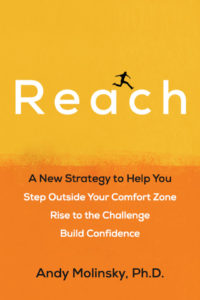You’d like to contribute to discussions at your company, but can never get a word in edgewise. You know you need to network, but you feel uneasy starting conversations with strangers. You need to start emphasizing your professional accomplishments at work to be noticed, but you feel deeply uncomfortable about tooting your own horn.
As we grow and learn and advance in our jobs and in our careers, we’re constantly faced with situations outside our comfort zones where we need to adapt and adjust our behavioral styles. That’s just the reality; and without the ability — and courage — to step outside our comfort zone and learn to stretch and flex our behavior, it’s very difficult to be successful. As Marissa Mayer, soon to be ex-president and chief executive officer of Yahoo has noted, doing something you’re not ready to do is essential to personal growth: “I always did something I was a little not ready to do. I think that’s how you grow. When there’s that moment of ‘Wow, I’m not really sure I can do this,’ and you push through those moments, that’s when you have a breakthrough.”
And how can you have this breakthrough? How can you muster up the courage and confidence to take that leap outside your comfort zone? But what I’ve learned from the past several years interviewing and working closely with entrepreneurs, managers and executives is that there are two essential tools successful people can use to make the types of leaps Mayer is talking about.
Tool 1: Conviction, or a deep sense of purpose. To take a leap and act against the grain of your personality, or your typical way of behaving, you have to know what’s in it for you: why the pain is worth the gain. In some cases, the answer might be professional — for example, in order to progress in my career, or build my company, I simply need to, say, get up the courage to make this business pitch. And in this case, that professional goal or ambition is your source of conviction.
But in other cases, conviction is more personal. Perhaps what motivates you to walk into that networking event (when you’d rather eat nails) or participate in that meeting (when you’re terrified of public speaking) is that you want to be a role model for your kids. Perhaps you tell your kids to be brave, and you realize that perhaps it’s time for you to step up as well? Wherever your source of motivation comes from – locate it, embrace it, and carry it with you into difficult situations.
Tool 2: Personalization. There’s no one size fits all version of a networking event or company pitch or layoff announcement. Though it might seem you need to mimic the “best practices” of “experts,” the reality is that you have more leeway than you think to make a situation your own: to put that little personal spin that makes a situation feel just that little bit more authentic.
For example, when pitching your ideas to venture capitalists, you might script out the first few sentences, or wear that lucky ring or power suit to boost your confidence, or bring a colleague you know can cover for you if you lose your train of thought (or courage), or go early to the room you’re going to pitch in, if possible, to scope out the setting and feel a bit more comfortable. I recently spoke with a banker terrified of public speaking the other day who told me he flew in a buddy from out of town to sit 8th row center during his speech, just to have a friendly face in the audience. Whatever the personalization is for you – make it your own and you’ll feel that much more confident.
In the end, Mayer is right — you do need to push through anxiety and fear to have a breakthrough. It might not always be successful at first; Marissa Mayer certainly had her share of struggles during her tenure at Yahoo. But what I’ve learned from my own research is that you can bring plenty of useful tools to the table to increase the odds of that breakthrough actually happening.
The material in this post is adapted from my new book Reach: A New Strategy to Help You Step Outside Your Comfort Zone, Rise to the Challenge, and Build Confidence (January, 2017 with Penguin Random House).
Originally published on Inc.com
AVAILABLE NOW
Reach A New Strategy to Help You Step Outside Your Comfort Zone
According to Andy Molinsky, an expert on behavior in the business world, there are five key challenges underlying our avoidance tendencies: authenticity, competence, resentment, likability and morality. Does the new behavior you’re attempting feel authentic to you? Is it the right thing to do? Answering these questions will help identify the “gap” in our behavioral style that we can then bridge by using the three Cs: Clarity, Conviction, and Customization. Perhaps most interesting, Molinsky has discovered that many people who confront what they were avoiding come to realize that they actually enjoy it, and can even be good at it.
